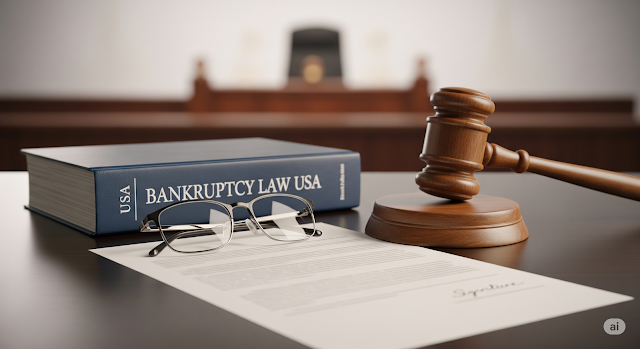How Do Bankruptcies Work in the USA? A Simple Guide
How does bankruptcy work in the USA? This easy-to-read guide explains the types, process, benefits, and life after filing. Understand your legal...
In the United States, many people and businesses face serious financial problems. They may lose their jobs, deal with medical emergencies, or experience a business failure. When they cannot pay their bills, loans, or credit card debt, bankruptcy can provide relief. Bankruptcy is a legal process that helps individuals or businesses manage or eliminate their debt through the court. It offers protection from creditors and gives a chance to rebuild financial stability.
What Debts Can Be Cleared?
Debts That Can Be Discharged:
Pros and Cons of Bankruptcy
Advantages:
Life After Bankruptcy
This article explains how bankruptcy works in the USA. It covers the types of bankruptcy, who can file, the full process, what happens to your property, which debts are cleared, and what life looks like after filing. The guide is written in simple, easy-to-understand language.
What is Bankruptcy?
What is Bankruptcy?
Bankruptcy is a legal solution for people or businesses who cannot pay back their debts. It is handled by federal courts and gives people two main options:
Why Do People File for Bankruptcy?
People choose bankruptcy for different reasons. Common causes include:
Types of Bankruptcy in the USA
- To eliminate (discharge) most of their debts.
- To repay debts over time through a court-approved plan.
Why Do People File for Bankruptcy?
People choose bankruptcy for different reasons. Common causes include:
- Job loss or a significant pay cut.
- Medical emergencies or high hospital bills.
- Divorce or separation.
- Business failure or loss of income.
- Rising credit card debt or personal loans.
Types of Bankruptcy in the USA
There are several types of bankruptcy under U.S. law, but the most common ones are:
1. Chapter 7 Bankruptcy – Liquidation
Chapter 7 is the most common form of bankruptcy for individuals. In this type:
2. Chapter 13 Bankruptcy – Repayment Plan
In Chapter 13, you do not lose your property. Instead, you:
3. Chapter 11 Bankruptcy – Business Reorganization
Chapter 11 is mostly used by businesses and some high-income individuals. It allows businesses to:
Who Can File for Bankruptcy?
1. Chapter 7 Bankruptcy – Liquidation
Chapter 7 is the most common form of bankruptcy for individuals. In this type:
- Some of your property may be sold to pay your creditors.
- Many of your unsecured debts, like credit cards and medical bills, are erased.
- Most essential items (clothes, furniture, car, and home equity) are protected under exemption laws.
2. Chapter 13 Bankruptcy – Repayment Plan
In Chapter 13, you do not lose your property. Instead, you:
- Propose a repayment plan to the court.
- Pay off a portion of your debt over 3 to 5 years.
- Receive debt discharge after completing the plan.
3. Chapter 11 Bankruptcy – Business Reorganization
Chapter 11 is mostly used by businesses and some high-income individuals. It allows businesses to:
- Continue operations.
- Restructure their debts.
- Negotiate payment plans with creditors.
Who Can File for Bankruptcy?
Anyone living or working in the U.S. can file for bankruptcy if they meet certain requirements:
The Bankruptcy Process: Step-by-Step
Understanding the bankruptcy process can help reduce fear and confusion. Here are the steps:
1. Credit Counseling Course
Before filing, you must complete a one-hour course from an approved provider. This course teaches you about budgeting and debt alternatives.
2. Hire a Bankruptcy Attorney (Optional)
Filing without a lawyer is allowed, but it’s not recommended. Bankruptcy laws are complex, and errors can delay or harm your case. A qualified lawyer will guide you through the process.
3. Gather Financial Documents
Prepare records such as:
You or your lawyer will file the required forms with your local federal bankruptcy court. Filing includes all your financial details and begins your case.
5. Automatic Stay Starts
Immediately after filing, an automatic stay goes into effect. Creditors must stop calling you, sending bills, filing lawsuits, garnishing wages, or trying to take your property.
6. Attend the 341 Meeting (Meeting of Creditors)
This is a short meeting with a bankruptcy trustee (not a judge). You will answer simple questions under oath about your finances. Creditors can attend but usually do not.
7. Take a Second Course (Debtor Education)
You must complete a financial education course before your debts can be discharged. It usually takes 1 to 2 hours and is available online.
8. Receive Discharge or Begin Repayment
Once everything is complete, the court officially closes your case. You receive a discharge letter (proof that debts have been erased).
What Happens to My Property?
Many people are afraid they will lose everything. That is not true. Most people keep their home, car, and personal items.
- You must be unable to pay your debts.
- You must complete a credit counseling course from an approved agency within 180 days before filing.
- If filing Chapter 7, you must pass a means test — your income must be below a certain level based on your state and family size.
The Bankruptcy Process: Step-by-Step
Understanding the bankruptcy process can help reduce fear and confusion. Here are the steps:
1. Credit Counseling Course
Before filing, you must complete a one-hour course from an approved provider. This course teaches you about budgeting and debt alternatives.
2. Hire a Bankruptcy Attorney (Optional)
Filing without a lawyer is allowed, but it’s not recommended. Bankruptcy laws are complex, and errors can delay or harm your case. A qualified lawyer will guide you through the process.
3. Gather Financial Documents
Prepare records such as:
- Income proof (pay stubs or tax returns).
- Debt list (credit cards, loans, bills).
- Expenses (rent, food, utilities).
- Property and asset details.
- Bank statements.
You or your lawyer will file the required forms with your local federal bankruptcy court. Filing includes all your financial details and begins your case.
5. Automatic Stay Starts
Immediately after filing, an automatic stay goes into effect. Creditors must stop calling you, sending bills, filing lawsuits, garnishing wages, or trying to take your property.
6. Attend the 341 Meeting (Meeting of Creditors)
This is a short meeting with a bankruptcy trustee (not a judge). You will answer simple questions under oath about your finances. Creditors can attend but usually do not.
7. Take a Second Course (Debtor Education)
You must complete a financial education course before your debts can be discharged. It usually takes 1 to 2 hours and is available online.
8. Receive Discharge or Begin Repayment
- In Chapter 7, most of your debts are cleared after the meeting and review.
- In Chapter 13, your repayment plan begins, and you must make monthly payments for 3 to 5 years.
Once everything is complete, the court officially closes your case. You receive a discharge letter (proof that debts have been erased).
What Happens to My Property?
Many people are afraid they will lose everything. That is not true. Most people keep their home, car, and personal items.
- In Chapter 7, the trustee may sell non-essential property to pay your creditors. But basic items are protected under state exemption laws, such as:
- Clothing
- Basic household furniture
- Tools for work
- Some home equity
- A reasonably valued car
- In Chapter 13, you keep everything, but must follow your repayment plan.
What Debts Can Be Cleared?
Debts That Can Be Discharged:
- Credit card debt
- Personal loans
- Medical bills
- Utility bills
- Old rent
- Collection accounts
- Student loans (except in rare cases)
- Child support and alimony
- Most taxes
- Court fines
- Debts from fraud or criminal acts
Pros and Cons of Bankruptcy
Advantages:
- Stops creditor harassment.
- Erases most unsecured debts.
- Stops lawsuits, foreclosure, and wage garnishment.
- Offers a legal fresh start.
- Protects basic property under exemption laws.
- Lowers your credit score.
- Remains on your credit report (7–10 years).
- May make it harder to get credit, housing, or jobs.
- Some debts cannot be erased.
- Public record of filing.
Life After Bankruptcy
Filing for bankruptcy gives you a fresh start, but rebuilding takes time and effort. Here’s how to recover:
Frequently Asked Questions (FAQs)
Will bankruptcy remove all my debts?
No. It removes most unsecured debts, but not student loans, child support, or most taxes.
Will I lose my home or car?
Usually not. If you keep making payments, you may be able to keep your home and car, especially in Chapter 13.
Can I file without a lawyer?
Yes, but it is not recommended. Mistakes can delay or ruin your case.
How long does it take?
Yes, but there are waiting periods between filings (for example, 8 years between two Chapter 7 filings).
Conclusion
Bankruptcy is not the end — it is a new beginning. It is a legal process that can give you freedom from debt and stress. It protects you from creditors, allows you to keep most of your property, and helps you rebuild your life. Although it impacts your credit, the benefits are often worth it if you are deep in debt with no way out. Always speak to a bankruptcy attorney or financial advisor to find the best option for your situation. Bankruptcy may be the fresh start you need.
- Create and follow a monthly budget.
- Pay your bills on time.
- Use a secured credit card to rebuild credit.
- Avoid unnecessary borrowing.
- Save money for emergencies.
- 10 years (Chapter 7)
- 7 years (Chapter 13)
Frequently Asked Questions (FAQs)
Will bankruptcy remove all my debts?
No. It removes most unsecured debts, but not student loans, child support, or most taxes.
Will I lose my home or car?
Usually not. If you keep making payments, you may be able to keep your home and car, especially in Chapter 13.
Can I file without a lawyer?
Yes, but it is not recommended. Mistakes can delay or ruin your case.
How long does it take?
- Chapter 7: 3 to 6 months
- Chapter 13: 3 to 5 years (repayment period)
Yes, but there are waiting periods between filings (for example, 8 years between two Chapter 7 filings).
Conclusion
Bankruptcy is not the end — it is a new beginning. It is a legal process that can give you freedom from debt and stress. It protects you from creditors, allows you to keep most of your property, and helps you rebuild your life. Although it impacts your credit, the benefits are often worth it if you are deep in debt with no way out. Always speak to a bankruptcy attorney or financial advisor to find the best option for your situation. Bankruptcy may be the fresh start you need.




Join the conversation